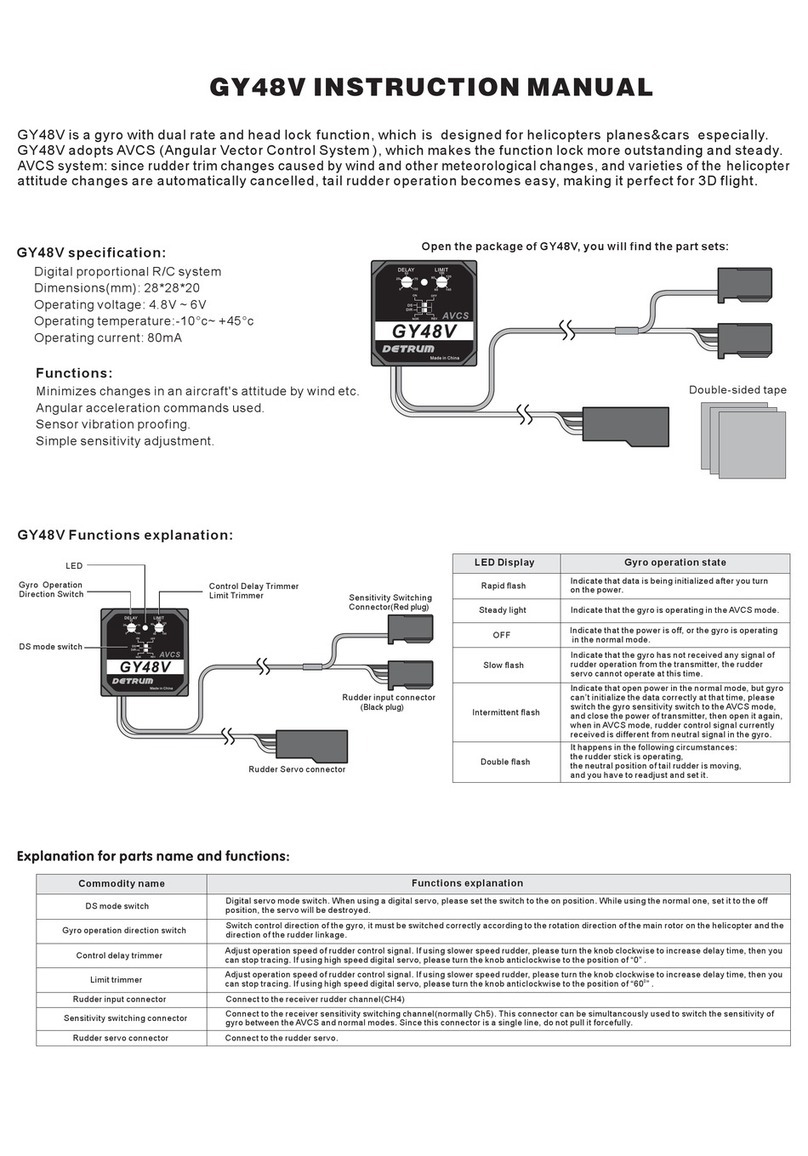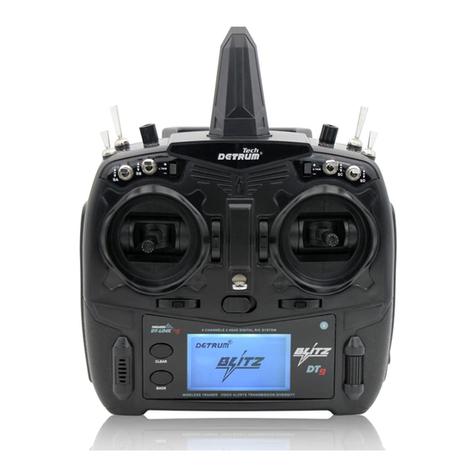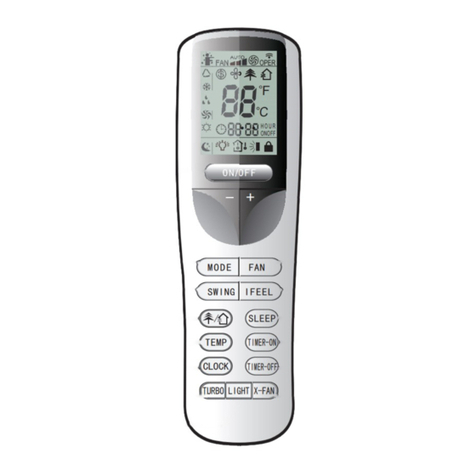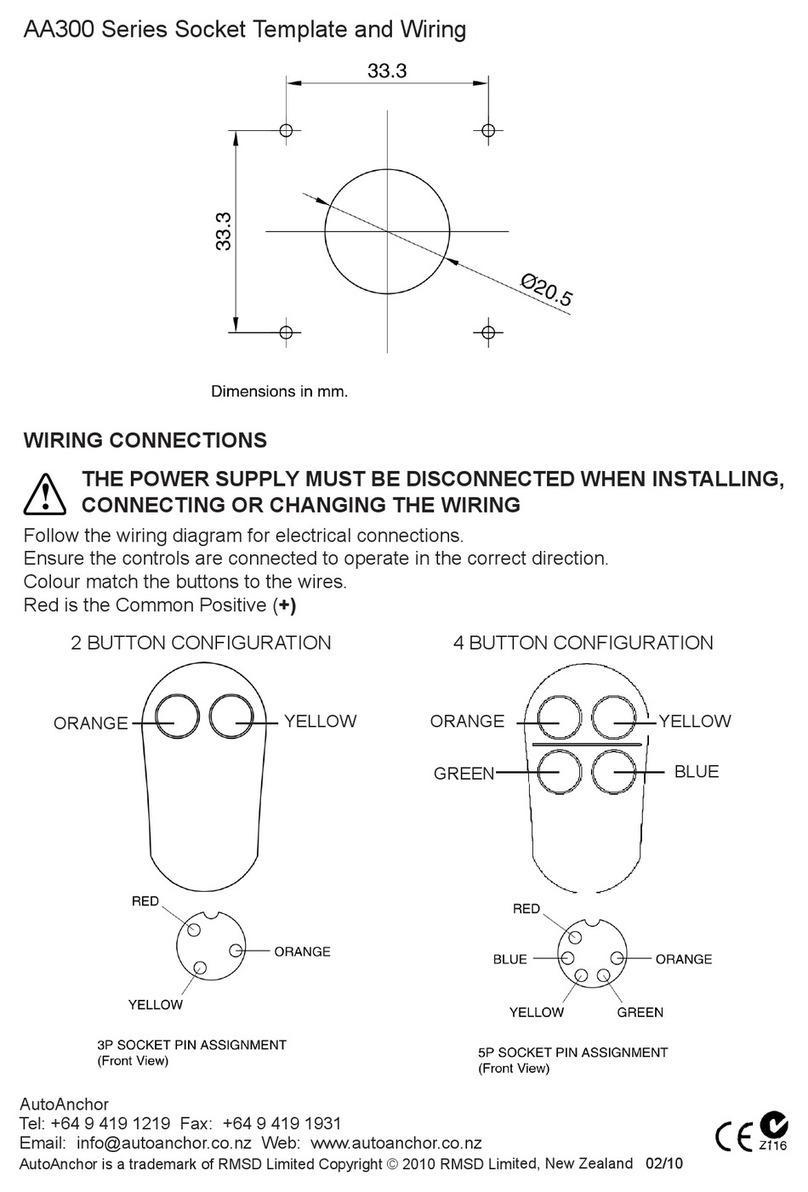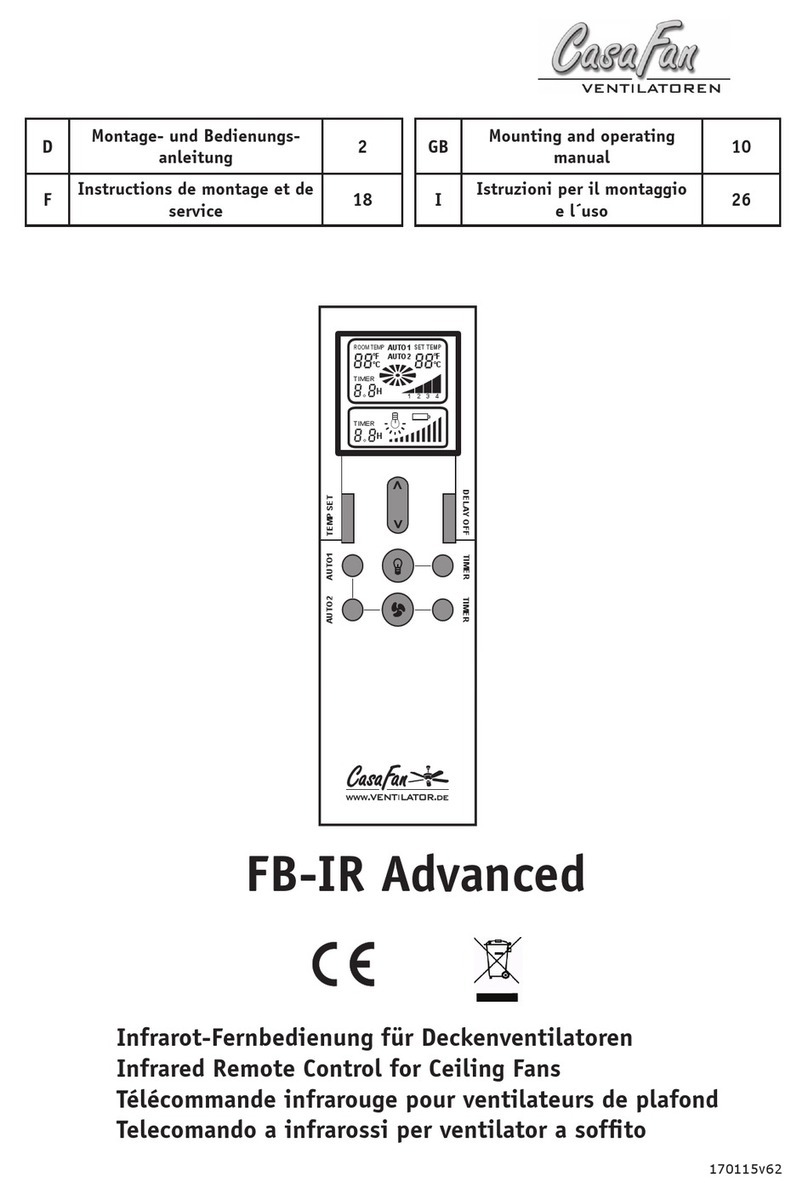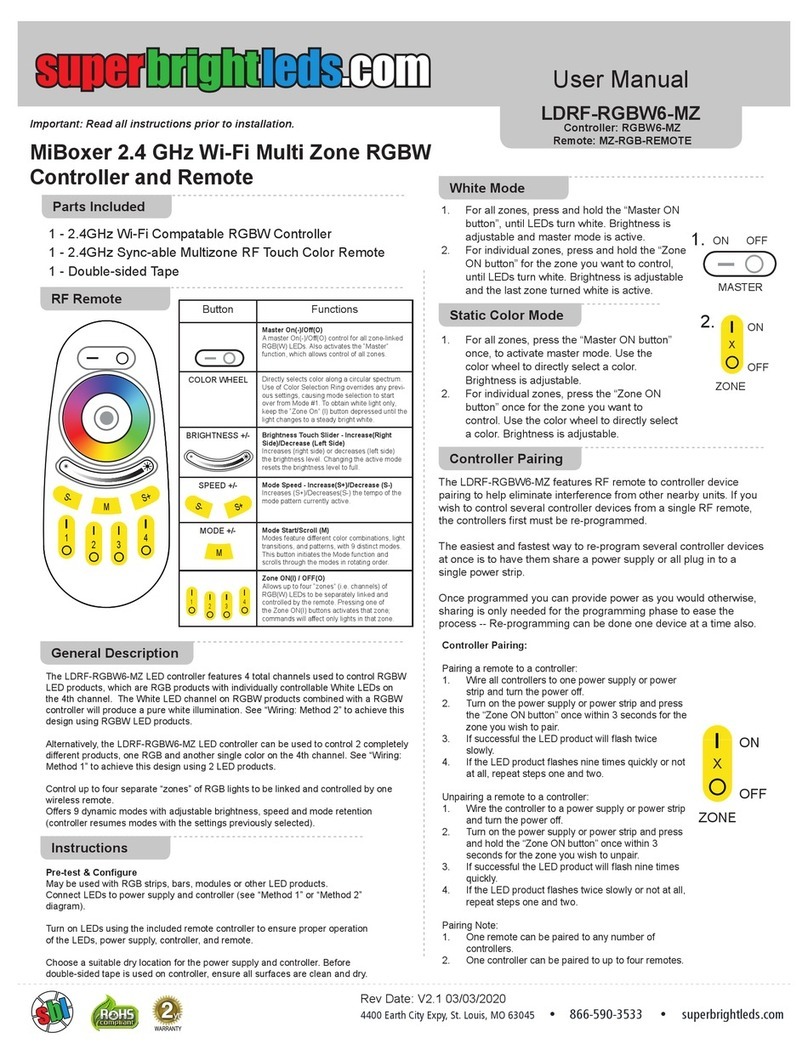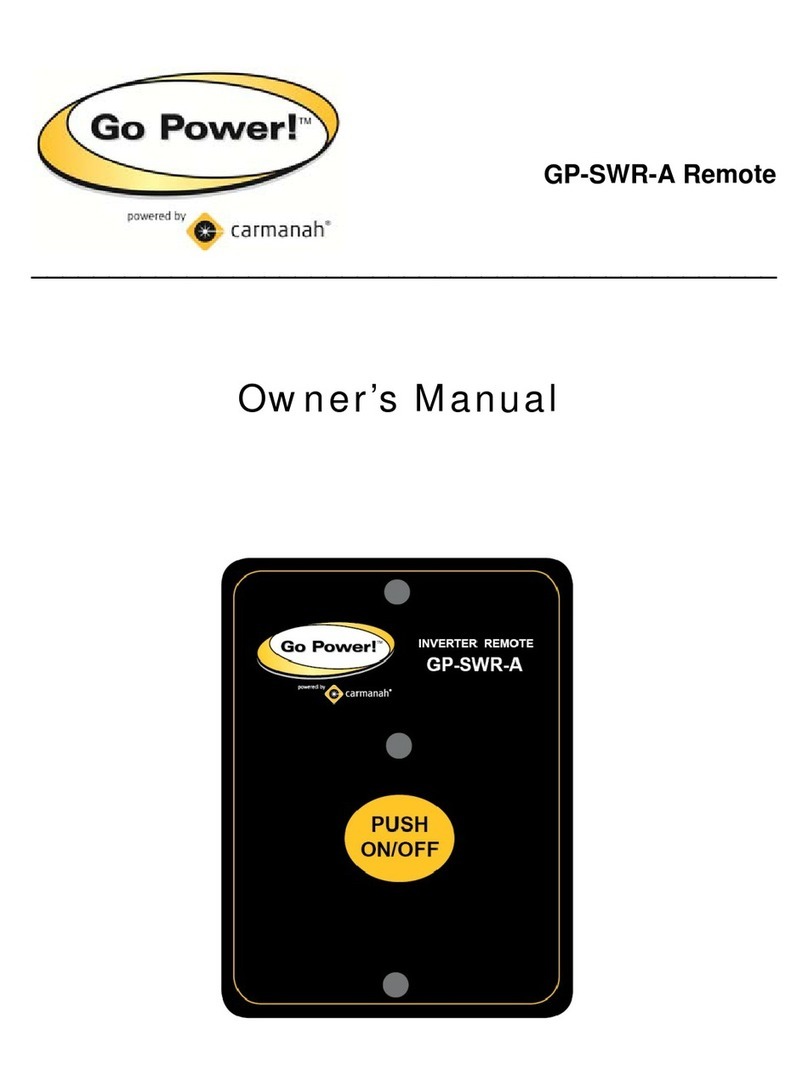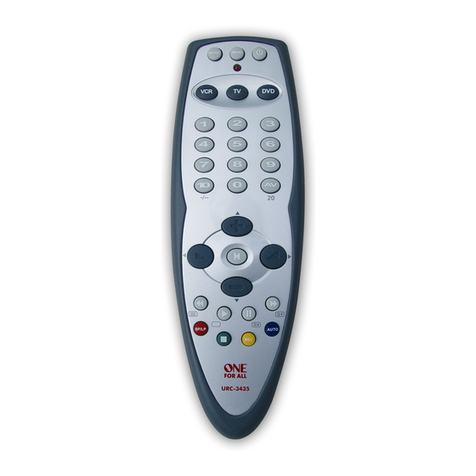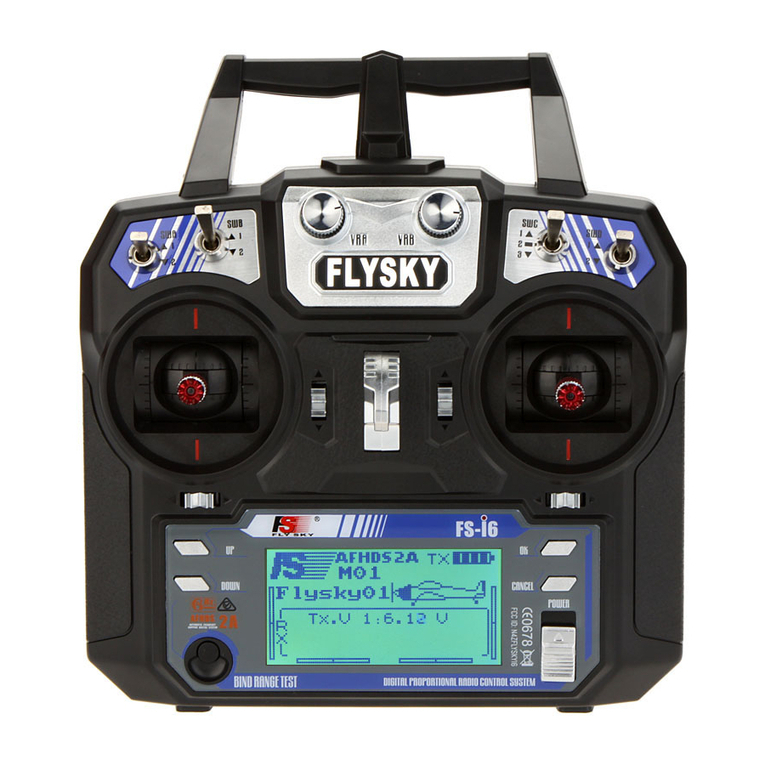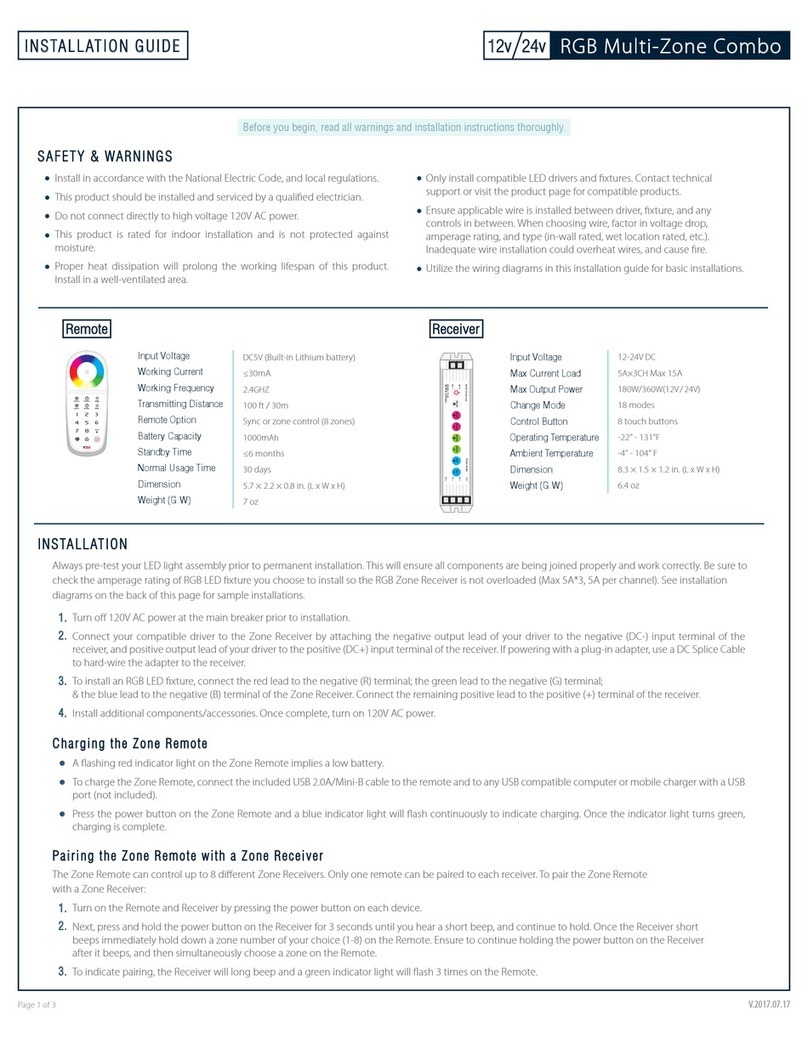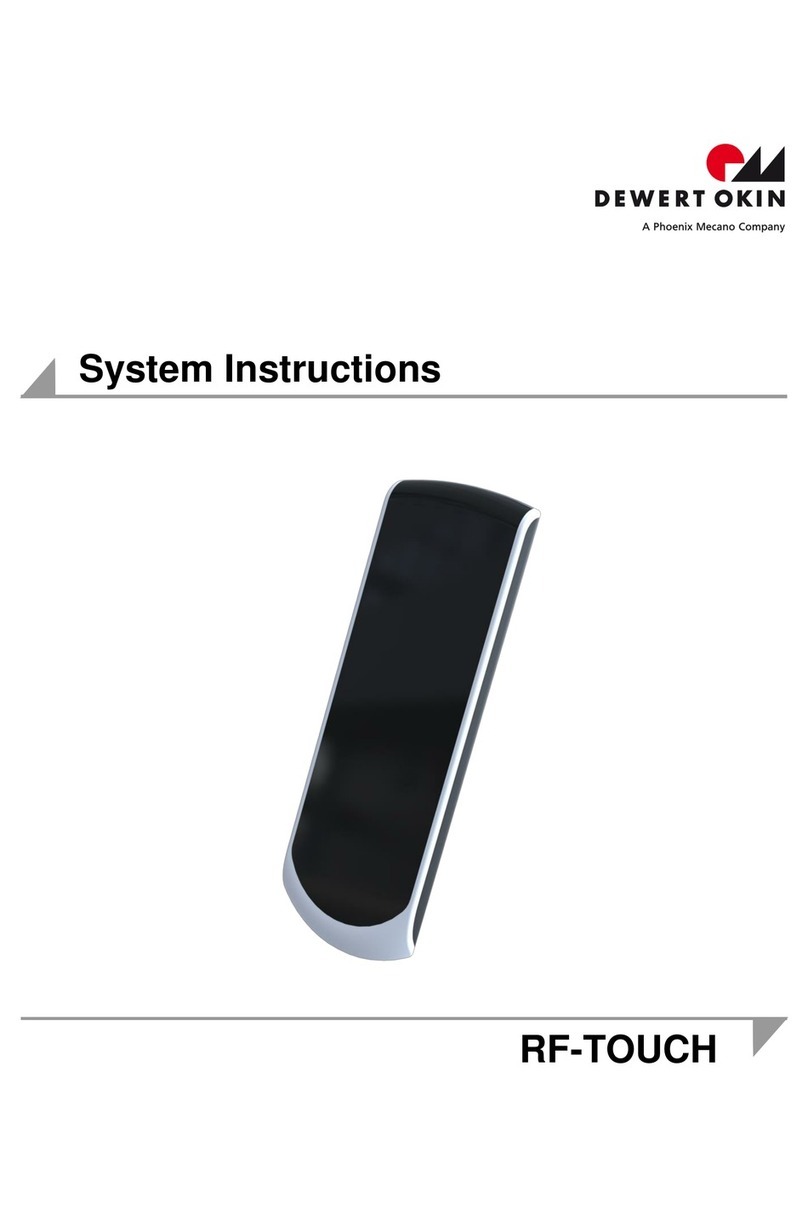DETRUM GAVIN-6A User manual

- 1 -
Introduction
Disclaimer
Thank you for purchasing this DETRUM product. This is a 2.4GHz digital proportional
R/C system with high performance. In order to make full use of the features of this
product and to safely enjoy your R/C activities, please read this manual carefully before
using. Please install and use this product in strict accordance with the manual. The
company assumes no liability or loss incurred directly or indirectly from improper use,
installation, or any modification of this product.
Products shall be subject to any changes without additional notices.
This product is suitable for users experienced in operating model aircraft and aged 14
years or older.
Please fly at a locally recognized model aircraft flying field.
Indications and Symbols for Safe Use
The following symbols used in this manual indicate the precautions regarding possible
danger which may occur following improper operation.
DANGER: Procedures, which if not properly followed, may lead to a dangerous
condition of death or serious injury.
WARNING: Procedures, which if not properly followed, may lead to a possibility of
death or serious injury.
CAUTION: Procedures, which if not properly followed, may lead to a possibility of
property damage, or a danger of injury.
Prohibited Mandatory
Installation Precautions
It is very important to properly install the R/C system on the model aircraft. Please refer
to the following instructions:
In order to protect the receiver, wrap the receiver with 10mm foam rubber, and then
fasten it with a rubber band or a Velcro strap.
The servos should be installed with rubber gaskets and brass eyelets to isolate the
vibration from the fuselage. Do not lock the screws too tight, otherwise the rubber
gasket will become distort and reduce the vibration-proof performance.
When mounting a servo, make sure that the servo can rotate over its full travel and
check that the push-rods and servo arms do not bind or contact each other.
When mounting a power switch, keep away from the engine's exhaust pipe and any
places with high vibration. And ensure that you can turn the switch on/off without
binding.
The two antennas of the receiver should be placed at 90 degrees to each other. Do
not place the two antennas twisted together or in parallel.
Flying Precautions
WARNING: Personal injury and property loss may be caused by improper aircraft
handling. Please operate strictly according to the following safety instructions.
Flying Field and Conditions:
In order to protect the personal safety and their property, please do not fly at the
following places:
Near another radio control flying field
Near or above people
Near residential areas, schools, hospitals or other places where people congregate
Near high-voltage lines, tall buildings, or communication facilities
Never fly on rainy day, thunder storm, when the wind is strong, and at night.
Always keep away from humidity environment.
The R/C system is composed of precision electronic components and mechanical
parts. Please keep away from humidity environment to prevent the components
damage from vapor and cause a failure which would lead to a crash.
Always keep away from heat sources.
The R/C system is composed of precision electronic components and mechanical
parts. Please keep it away from heat sources and sunshine to avoid distortion, or
even damage caused by high temperature.
Precautions before Flight:
Always make sure that all servos in the model work properly following the transmitter
stick movements prior to flight. And make sure that all switches work properly as
well.
Always check the remaining capacity of both the transmitter and receiver batteries
before each flying session prior to flight. Low battery capacity will cause loss of
control and a crash.
Always perform a range test before each flying session.
Always check the operation of each control surface before each flying session.
Precautions during Flight:
Never grasp the transmitter antenna during flight. Otherwise, the transmitter output
power will reduce drastically.
Do not point the antenna directly toward the aircraft during flight. When pointing the
antenna directly, the transmitter output is the weakest. The strong radio wave radiate
from the side of the transmitter antenna.
Never turn on and off the power switch of transmitter during flight or while the engine
or motor is running.
Do not touch the engine, motor, or other heating device during and immediately after
use. These devices or components may become hot during use.
For safety, always fly the aircraft in visible range. Flying behind tall buildings will not
only lose sight of the aircraft, but also degrade the RF signal performance.
Precautions in Other Conditions
When setting the transmitter during flight preparations, do not set it upright on the
ground. The transmitter may fall to the ground, the sticks may move and the servos
may rotate unexpectedly and cause injury.
Do not touch the receiver antenna directly by hands. Otherwise, the components
may be damaged by static, and this may cause a reduction in transmission distance
of the receiver.
Before turning on the transmitter, always make sure the transmitter throttle stick and
throttle trim are in the lowest position.
Always turn on the R/C system in proper sequence: turn on the transmitter first, then
turn on the receiver, and then turn on the engine or motor. Incorrect sequence may
cause loss of control and personal injury.
Always turn off the R/C system in proper sequence: turn off the engine or motor first,
then turn off the receiver, and then turn off the transmitter. Incorrect sequence may
cause loss of control and personal injury.
Product Description
Box Contents
The box includes the following components.
GAVIN-6ATransmitter
DETRUMRXC7Receiver
Bind Plug
Instruction Manual
Simulator Converter (optional)
9g Servo *4pcs (optional)
NOTE: The set contents depend on the type of set.
Specifications
Transmitter: GAVIN-6A
Channel
6-channel
Transmitting frequency
2.4GHz
Power supply
1.5V AA batteries *4pcs
Consuming current
less than or equal to 200mA
Output power
100mW
Output pulse
1000ms~2000ms (neutral 1500ms)
Receiver: DETRUM RXC7
Type
2.4GHz 7-channel
Sensitivity
-95dBm
Frequency interval
larger than or equal to 4MHz
Power supply
4V~6.5V
Size
39mm * 28.5mm * 14.5mm
Weight
10g
Features
GAVIN-6A is a 2.4GHz 6-channel transmitter, applicable for airplanes. It is designed with
the following features:
Wireless IC
Adopting wireless chips, with extended power amplifier (PA) and low noise amplifier
(LNA), can extremely improve the system output power and receiving sensitivity,
thereby improving the signal coverage.
All-angle antenna
By using all-band gain antenna on the transmitter, the transmitting efficiency is
greatly improved. By using diversity antenna on the receiver, combined with the
signal detection and switching algorithm, the receiving signal is stable and reliable.
Long distance stable operating
Adopting 2.4GHz direct sequence spread spectrum (DSSS) and multiple
frequency-hopping spread spectrum (FHSS) technology, the R/C system has high
receiving sensitivity and strong anti-interference capability, can support a stable
operating for more than 1,000 meters on the ground and more than 1,600 meters in
the air.
Unique ID code
Each transmitter has an individually assigned, unique ID code. Once the binding is
made, the ID code is stored in the receiver and no further binding is necessary after
restarting the receiver. When the receiver is working, it will verify whether the ID
code of the transmitter is being paired, to enhance the stability of the R/C system.
Mixing function
Support V-tail mixing and Elevon mixing, one button togglable.
High section precision
By using the 4096 section precision sticks, you can experience a smooth flight
operation.
Low power consumption
Using low power devices and transmitting the signals at intervals, this will reduce the
transmitting power, also lead to low battery power consumption and longer battery
life.
Low voltage alarm
Have battery level LED indicators and low battery alarm function, the flight is safer.
Double bearing structure
Double bearing assembly sticks provide precise control and excellent operating
experience and won’t come loose even working for a long time.
One-click rescue
Combined with optional SR86A receiver (with gyro integrated) or ISTONE-A PRO
flight controller for airplane, you can use one-click rescue function, which is designed
for new beginners.
Transmitter Controls
6
6-CHANNEL PR OPORTIONA L RADIO CON TROL SYSTEM
Antenna
Neck Strap Attachment
Elevator Trim
Throttle Trim
Rudder Trim Aileron Trim
Power Switch
Mix Switch
HI/LO Rate Switch
Reversing Switches
MODE 2
CH5 Switch CH6 Switch
Throttle
Rudder
Elevator
Aileron
LED1~LED4
Simulator Plug
6
6-CHANNEL PRO PORTIONAL R ADIO CONTROL SYST EM
Antenna
Neck Strap Attachment
Throttle Trim
Elevator Trim
Rudder Trim Aileron Trim
Power Switch
Mix Switch
HI/LO Rate Switch
Reversing Switches
MODE 1
CH5 Switch CH6 Switch
Elevator
Rudder
Throttle
Aileron
LED1~LED4
Simulator Plug
GAVIN-6A
6-Channel 2.4GHz Digital Proportional R/C System
6通道2.4GHz遥控设备
INSTRUCTION MANUAL
使用说明书
AIL
REV
NOR
HI
LO
ELE THR RUD RATE
SERVOREVERSING 6
AILEVATOR
OFF
V-TAIL
6-CHANNE L P ROPORTIONA LRADIO CONTRO LS YST EM
2.4GHZSYSTEM

- 1 -
Introduction
Disclaimer
Thank you for purchasing this DETRUM product. This is a 2.4GHz digital proportional
R/C system with high performance. In order to make full use of the features of this
product and to safely enjoy your R/C activities, please read this manual carefully before
using. Please install and use this product in strict accordance with the manual. The
company assumes no liability or loss incurred directly or indirectly from improper use,
installation, or any modification of this product.
Products shall be subject to any changes without additional notices.
This product is suitable for users experienced in operating model aircraft and aged 14
years or older.
Please fly at a locally recognized model aircraft flying field.
Indications and Symbols for Safe Use
The following symbols used in this manual indicate the precautions regarding possible
danger which may occur following improper operation.
DANGER: Procedures, which if not properly followed, may lead to a dangerous
condition of death or serious injury.
WARNING: Procedures, which if not properly followed, may lead to a possibility of
death or serious injury.
CAUTION: Procedures, which if not properly followed, may lead to a possibility of
property damage, or a danger of injury.
Prohibited Mandatory
Installation Precautions
It is very important to properly install the R/C system on the model aircraft. Please refer
to the following instructions:
In order to protect the receiver, wrap the receiver with 10mm foam rubber, and then
fasten it with a rubber band or a Velcro strap.
The servos should be installed with rubber gaskets and brass eyelets to isolate the
vibration from the fuselage. Do not lock the screws too tight, otherwise the rubber
gasket will become distort and reduce the vibration-proof performance.
When mounting a servo, make sure that the servo can rotate over its full travel and
check that the push-rods and servo arms do not bind or contact each other.
When mounting a power switch, keep away from the engine's exhaust pipe and any
places with high vibration. And ensure that you can turn the switch on/off without
binding.
The two antennas of the receiver should be placed at 90 degrees to each other. Do
not place the two antennas twisted together or in parallel.
Flying Precautions
WARNING: Personal injury and property loss may be caused by improper aircraft
handling. Please operate strictly according to the following safety instructions.
Flying Field and Conditions:
In order to protect the personal safety and their property, please do not fly at the
following places:
Near another radio control flying field
Near or above people
Near residential areas, schools, hospitals or other places where people congregate
Near high-voltage lines, tall buildings, or communication facilities
Never fly on rainy day, thunder storm, when the wind is strong, and at night.
Always keep away from humidity environment.
The R/C system is composed of precision electronic components and mechanical
parts. Please keep away from humidity environment to prevent the components
damage from vapor and cause a failure which would lead to a crash.
Always keep away from heat sources.
The R/C system is composed of precision electronic components and mechanical
parts. Please keep it away from heat sources and sunshine to avoid distortion, or
even damage caused by high temperature.
Precautions before Flight:
Always make sure that all servos in the model work properly following the transmitter
stick movements prior to flight. And make sure that all switches work properly as
well.
Always check the remaining capacity of both the transmitter and receiver batteries
before each flying session prior to flight. Low battery capacity will cause loss of
control and a crash.
Always perform a range test before each flying session.
Always check the operation of each control surface before each flying session.
Precautions during Flight:
Never grasp the transmitter antenna during flight. Otherwise, the transmitter output
power will reduce drastically.
Do not point the antenna directly toward the aircraft during flight. When pointing the
antenna directly, the transmitter output is the weakest. The strong radio wave radiate
from the side of the transmitter antenna.
Never turn on and off the power switch of transmitter during flight or while the engine
or motor is running.
Do not touch the engine, motor, or other heating device during and immediately after
use. These devices or components may become hot during use.
For safety, always fly the aircraft in visible range. Flying behind tall buildings will not
only lose sight of the aircraft, but also degrade the RF signal performance.
Precautions in Other Conditions
When setting the transmitter during flight preparations, do not set it upright on the
ground. The transmitter may fall to the ground, the sticks may move and the servos
may rotate unexpectedly and cause injury.
Do not touch the receiver antenna directly by hands. Otherwise, the components
may be damaged by static, and this may cause a reduction in transmission distance
of the receiver.
Before turning on the transmitter, always make sure the transmitter throttle stick and
throttle trim are in the lowest position.
Always turn on the R/C system in proper sequence: turn on the transmitter first, then
turn on the receiver, and then turn on the engine or motor. Incorrect sequence may
cause loss of control and personal injury.
Always turn off the R/C system in proper sequence: turn off the engine or motor first,
then turn off the receiver, and then turn off the transmitter. Incorrect sequence may
cause loss of control and personal injury.
Product Description
Box Contents
The box includes the following components.
GAVIN-6ATransmitter
DETRUMRXC7Receiver
Bind Plug
Instruction Manual
Simulator Converter (optional)
9g Servo *4pcs (optional)
NOTE: The set contents depend on the type of set.
Specifications
Transmitter: GAVIN-6A
Channel
6-channel
Transmitting frequency
2.4GHz
Power supply
1.5V AA batteries *4pcs
Consuming current
less than or equal to 200mA
Output power
100mW
Output pulse
1000ms~2000ms (neutral 1500ms)
Receiver: DETRUM RXC7
Type
2.4GHz 7-channel
Sensitivity
-95dBm
Frequency interval
larger than or equal to 4MHz
Power supply
4V~6.5V
Size
39mm * 28.5mm * 14.5mm
Weight
10g
Features
GAVIN-6A is a 2.4GHz 6-channel transmitter, applicable for airplanes. It is designed with
the following features:
Wireless IC
Adopting wireless chips, with extended power amplifier (PA) and low noise amplifier
(LNA), can extremely improve the system output power and receiving sensitivity,
thereby improving the signal coverage.
All-angle antenna
By using all-band gain antenna on the transmitter, the transmitting efficiency is
greatly improved. By using diversity antenna on the receiver, combined with the
signal detection and switching algorithm, the receiving signal is stable and reliable.
Long distance stable operating
Adopting 2.4GHz direct sequence spread spectrum (DSSS) and multiple
frequency-hopping spread spectrum (FHSS) technology, the R/C system has high
receiving sensitivity and strong anti-interference capability, can support a stable
operating for more than 1,000 meters on the ground and more than 1,600 meters in
the air.
Unique ID code
Each transmitter has an individually assigned, unique ID code. Once the binding is
made, the ID code is stored in the receiver and no further binding is necessary after
restarting the receiver. When the receiver is working, it will verify whether the ID
code of the transmitter is being paired, to enhance the stability of the R/C system.
Mixing function
Support V-tail mixing and Elevon mixing, one button togglable.
High section precision
By using the 4096 section precision sticks, you can experience a smooth flight
operation.
Low power consumption
Using low power devices and transmitting the signals at intervals, this will reduce the
transmitting power, also lead to low battery power consumption and longer battery
life.
Low voltage alarm
Have battery level LED indicators and low battery alarm function, the flight is safer.
Double bearing structure
Double bearing assembly sticks provide precise control and excellent operating
experience and won’t come loose even working for a long time.
One-click rescue
Combined with optional SR86A receiver (with gyro integrated) or ISTONE-A PRO
flight controller for airplane, you can use one-click rescue function, which is designed
for new beginners.
Transmitter Controls
6
6-CHANNEL PR OPORTIONA L RADIO CON TROL SYSTEM
Antenna
Neck Strap Attachment
Elevator Trim
Throttle Trim
Rudder Trim Aileron Trim
Power Switch
Mix Switch
HI/LO Rate Switch
Reversing Switches
MODE 2
CH5 Switch CH6 Switch
Throttle
Rudder
Elevator
Aileron
LED1~LED4
Simulator Plug
6
6-CHANNEL PRO PORTIONAL R ADIO CONTROL SYST EM
Antenna
Neck Strap Attachment
Throttle Trim
Elevator Trim
Rudder Trim Aileron Trim
Power Switch
Mix Switch
HI/LO Rate Switch
Reversing Switches
MODE 1
CH5 Switch CH6 Switch
Elevator
Rudder
Throttle
Aileron
LED1~LED4
Simulator Plug
GAVIN-6A
6-Channel 2.4GHz Digital Proportional R/C System
6通道2.4GHz遥控设备
INSTRUCTION MANUAL
使用说明书
AIL
REV
NOR
HI
LO
ELE THR RUD RATE
SERVOREVERSING 6
AILEVATOR
OFF
V-TAIL
6-CHANNE L P ROPORTIONA LRADIO CONTRO LS YST EM
2.4GHZSYSTEM

- 1 -
Introduction
Disclaimer
Thank you for purchasing this DETRUM product. This is a 2.4GHz digital proportional
R/C system with high performance. In order to make full use of the features of this
product and to safely enjoy your R/C activities, please read this manual carefully before
using. Please install and use this product in strict accordance with the manual. The
company assumes no liability or loss incurred directly or indirectly from improper use,
installation, or any modification of this product.
Products shall be subject to any changes without additional notices.
This product is suitable for users experienced in operating model aircraft and aged 14
years or older.
Please fly at a locally recognized model aircraft flying field.
Indications and Symbols for Safe Use
The following symbols used in this manual indicate the precautions regarding possible
danger which may occur following improper operation.
DANGER: Procedures, which if not properly followed, may lead to a dangerous
condition of death or serious injury.
WARNING: Procedures, which if not properly followed, may lead to a possibility of
death or serious injury.
CAUTION: Procedures, which if not properly followed, may lead to a possibility of
property damage, or a danger of injury.
Prohibited Mandatory
Installation Precautions
It is very important to properly install the R/C system on the model aircraft. Please refer
to the following instructions:
In order to protect the receiver, wrap the receiver with 10mm foam rubber, and then
fasten it with a rubber band or a Velcro strap.
The servos should be installed with rubber gaskets and brass eyelets to isolate the
vibration from the fuselage. Do not lock the screws too tight, otherwise the rubber
gasket will become distort and reduce the vibration-proof performance.
When mounting a servo, make sure that the servo can rotate over its full travel and
check that the push-rods and servo arms do not bind or contact each other.
When mounting a power switch, keep away from the engine's exhaust pipe and any
places with high vibration. And ensure that you can turn the switch on/off without
binding.
The two antennas of the receiver should be placed at 90 degrees to each other. Do
not place the two antennas twisted together or in parallel.
Flying Precautions
WARNING: Personal injury and property loss may be caused by improper aircraft
handling. Please operate strictly according to the following safety instructions.
Flying Field and Conditions:
In order to protect the personal safety and their property, please do not fly at the
following places:
Near another radio control flying field
Near or above people
Near residential areas, schools, hospitals or other places where people congregate
Near high-voltage lines, tall buildings, or communication facilities
Never fly on rainy day, thunder storm, when the wind is strong, and at night.
Always keep away from humidity environment.
The R/C system is composed of precision electronic components and mechanical
parts. Please keep away from humidity environment to prevent the components
damage from vapor and cause a failure which would lead to a crash.
Always keep away from heat sources.
The R/C system is composed of precision electronic components and mechanical
parts. Please keep it away from heat sources and sunshine to avoid distortion, or
even damage caused by high temperature.
Precautions before Flight:
Always make sure that all servos in the model work properly following the transmitter
stick movements prior to flight. And make sure that all switches work properly as
well.
Always check the remaining capacity of both the transmitter and receiver batteries
before each flying session prior to flight. Low battery capacity will cause loss of
control and a crash.
Always perform a range test before each flying session.
Always check the operation of each control surface before each flying session.
Precautions during Flight:
Never grasp the transmitter antenna during flight. Otherwise, the transmitter output
power will reduce drastically.
Do not point the antenna directly toward the aircraft during flight. When pointing the
antenna directly, the transmitter output is the weakest. The strong radio wave radiate
from the side of the transmitter antenna.
Never turn on and off the power switch of transmitter during flight or while the engine
or motor is running.
Do not touch the engine, motor, or other heating device during and immediately after
use. These devices or components may become hot during use.
For safety, always fly the aircraft in visible range. Flying behind tall buildings will not
only lose sight of the aircraft, but also degrade the RF signal performance.
Precautions in Other Conditions
When setting the transmitter during flight preparations, do not set it upright on the
ground. The transmitter may fall to the ground, the sticks may move and the servos
may rotate unexpectedly and cause injury.
Do not touch the receiver antenna directly by hands. Otherwise, the components
may be damaged by static, and this may cause a reduction in transmission distance
of the receiver.
Before turning on the transmitter, always make sure the transmitter throttle stick and
throttle trim are in the lowest position.
Always turn on the R/C system in proper sequence: turn on the transmitter first, then
turn on the receiver, and then turn on the engine or motor. Incorrect sequence may
cause loss of control and personal injury.
Always turn off the R/C system in proper sequence: turn off the engine or motor first,
then turn off the receiver, and then turn off the transmitter. Incorrect sequence may
cause loss of control and personal injury.
Product Description
Box Contents
The box includes the following components.
GAVIN-6ATransmitter
DETRUMRXC7Receiver
Bind Plug
Instruction Manual
Simulator Converter (optional)
9g Servo *4pcs (optional)
NOTE: The set contents depend on the type of set.
Specifications
Transmitter: GAVIN-6A
Channel
6-channel
Transmitting frequency
2.4GHz
Power supply
1.5V AA batteries *4pcs
Consuming current
less than or equal to 200mA
Output power
100mW
Output pulse
1000ms~2000ms (neutral 1500ms)
Receiver: DETRUM RXC7
Type
2.4GHz 7-channel
Sensitivity
-95dBm
Frequency interval
larger than or equal to 4MHz
Power supply
4V~6.5V
Size
39mm * 28.5mm * 14.5mm
Weight
10g
Features
GAVIN-6A is a 2.4GHz 6-channel transmitter, applicable for airplanes. It is designed with
the following features:
Wireless IC
Adopting wireless chips, with extended power amplifier (PA) and low noise amplifier
(LNA), can extremely improve the system output power and receiving sensitivity,
thereby improving the signal coverage.
All-angle antenna
By using all-band gain antenna on the transmitter, the transmitting efficiency is
greatly improved. By using diversity antenna on the receiver, combined with the
signal detection and switching algorithm, the receiving signal is stable and reliable.
Long distance stable operating
Adopting 2.4GHz direct sequence spread spectrum (DSSS) and multiple
frequency-hopping spread spectrum (FHSS) technology, the R/C system has high
receiving sensitivity and strong anti-interference capability, can support a stable
operating for more than 1,000 meters on the ground and more than 1,600 meters in
the air.
Unique ID code
Each transmitter has an individually assigned, unique ID code. Once the binding is
made, the ID code is stored in the receiver and no further binding is necessary after
restarting the receiver. When the receiver is working, it will verify whether the ID
code of the transmitter is being paired, to enhance the stability of the R/C system.
Mixing function
Support V-tail mixing and Elevon mixing, one button togglable.
High section precision
By using the 4096 section precision sticks, you can experience a smooth flight
operation.
Low power consumption
Using low power devices and transmitting the signals at intervals, this will reduce the
transmitting power, also lead to low battery power consumption and longer battery
life.
Low voltage alarm
Have battery level LED indicators and low battery alarm function, the flight is safer.
Double bearing structure
Double bearing assembly sticks provide precise control and excellent operating
experience and won’t come loose even working for a long time.
One-click rescue
Combined with optional SR86A receiver (with gyro integrated) or ISTONE-A PRO
flight controller for airplane, you can use one-click rescue function, which is designed
for new beginners.
Transmitter Controls
6
6-CHANNEL PR OPORTIONA L RADIO CON TROL SYSTEM
Antenna
Neck Strap Attachment
Elevator Trim
Throttle Trim
Rudder Trim Aileron Trim
Power Switch
Mix Switch
HI/LO Rate Switch
Reversing Switches
MODE 2
CH5 Switch CH6 Switch
Throttle
Rudder
Elevator
Aileron
LED1~LED4
Simulator Plug
6
6-CHANNEL PRO PORTIONAL R ADIO CONTROL SYST EM
Antenna
Neck Strap Attachment
Throttle Trim
Elevator Trim
Rudder Trim Aileron Trim
Power Switch
Mix Switch
HI/LO Rate Switch
Reversing Switches
MODE 1
CH5 Switch CH6 Switch
Elevator
Rudder
Throttle
Aileron
LED1~LED4
Simulator Plug
GAVIN-6A
6-Channel 2.4GHz Digital Proportional R/C System
6通道2.4GHz遥控设备
INSTRUCTION MANUAL
使用说明书
AIL
REV
NOR
HI
LO
ELE THR RUD RATE
SERVOREVERSING 6
AILEVATOR
OFF
V-TAIL
6-CHANNE L P ROPORTIONA LRADIO CONTRO LS YST EM
2.4GHZSYSTEM

- 1 -
Introduction
Disclaimer
Thank you for purchasing this DETRUM product. This is a 2.4GHz digital proportional
R/C system with high performance. In order to make full use of the features of this
product and to safely enjoy your R/C activities, please read this manual carefully before
using. Please install and use this product in strict accordance with the manual. The
company assumes no liability or loss incurred directly or indirectly from improper use,
installation, or any modification of this product.
Products shall be subject to any changes without additional notices.
This product is suitable for users experienced in operating model aircraft and aged 14
years or older.
Please fly at a locally recognized model aircraft flying field.
Indications and Symbols for Safe Use
The following symbols used in this manual indicate the precautions regarding possible
danger which may occur following improper operation.
DANGER: Procedures, which if not properly followed, may lead to a dangerous
condition of death or serious injury.
WARNING: Procedures, which if not properly followed, may lead to a possibility of
death or serious injury.
CAUTION: Procedures, which if not properly followed, may lead to a possibility of
property damage, or a danger of injury.
Prohibited Mandatory
Installation Precautions
It is very important to properly install the R/C system on the model aircraft. Please refer
to the following instructions:
In order to protect the receiver, wrap the receiver with 10mm foam rubber, and then
fasten it with a rubber band or a Velcro strap.
The servos should be installed with rubber gaskets and brass eyelets to isolate the
vibration from the fuselage. Do not lock the screws too tight, otherwise the rubber
gasket will become distort and reduce the vibration-proof performance.
When mounting a servo, make sure that the servo can rotate over its full travel and
check that the push-rods and servo arms do not bind or contact each other.
When mounting a power switch, keep away from the engine's exhaust pipe and any
places with high vibration. And ensure that you can turn the switch on/off without
binding.
The two antennas of the receiver should be placed at 90 degrees to each other. Do
not place the two antennas twisted together or in parallel.
Flying Precautions
WARNING: Personal injury and property loss may be caused by improper aircraft
handling. Please operate strictly according to the following safety instructions.
Flying Field and Conditions:
In order to protect the personal safety and their property, please do not fly at the
following places:
Near another radio control flying field
Near or above people
Near residential areas, schools, hospitals or other places where people congregate
Near high-voltage lines, tall buildings, or communication facilities
Never fly on rainy day, thunder storm, when the wind is strong, and at night.
Always keep away from humidity environment.
The R/C system is composed of precision electronic components and mechanical
parts. Please keep away from humidity environment to prevent the components
damage from vapor and cause a failure which would lead to a crash.
Always keep away from heat sources.
The R/C system is composed of precision electronic components and mechanical
parts. Please keep it away from heat sources and sunshine to avoid distortion, or
even damage caused by high temperature.
Precautions before Flight:
Always make sure that all servos in the model work properly following the transmitter
stick movements prior to flight. And make sure that all switches work properly as
well.
Always check the remaining capacity of both the transmitter and receiver batteries
before each flying session prior to flight. Low battery capacity will cause loss of
control and a crash.
Always perform a range test before each flying session.
Always check the operation of each control surface before each flying session.
Precautions during Flight:
Never grasp the transmitter antenna during flight. Otherwise, the transmitter output
power will reduce drastically.
Do not point the antenna directly toward the aircraft during flight. When pointing the
antenna directly, the transmitter output is the weakest. The strong radio wave radiate
from the side of the transmitter antenna.
Never turn on and off the power switch of transmitter during flight or while the engine
or motor is running.
Do not touch the engine, motor, or other heating device during and immediately after
use. These devices or components may become hot during use.
For safety, always fly the aircraft in visible range. Flying behind tall buildings will not
only lose sight of the aircraft, but also degrade the RF signal performance.
Precautions in Other Conditions
When setting the transmitter during flight preparations, do not set it upright on the
ground. The transmitter may fall to the ground, the sticks may move and the servos
may rotate unexpectedly and cause injury.
Do not touch the receiver antenna directly by hands. Otherwise, the components
may be damaged by static, and this may cause a reduction in transmission distance
of the receiver.
Before turning on the transmitter, always make sure the transmitter throttle stick and
throttle trim are in the lowest position.
Always turn on the R/C system in proper sequence: turn on the transmitter first, then
turn on the receiver, and then turn on the engine or motor. Incorrect sequence may
cause loss of control and personal injury.
Always turn off the R/C system in proper sequence: turn off the engine or motor first,
then turn off the receiver, and then turn off the transmitter. Incorrect sequence may
cause loss of control and personal injury.
Product Description
Box Contents
The box includes the following components.
GAVIN-6ATransmitter
DETRUMRXC7Receiver
Bind Plug
Instruction Manual
Simulator Converter (optional)
9g Servo *4pcs (optional)
NOTE: The set contents depend on the type of set.
Specifications
Transmitter: GAVIN-6A
Channel
6-channel
Transmitting frequency
2.4GHz
Power supply
1.5V AA batteries *4pcs
Consuming current
less than or equal to 200mA
Output power
100mW
Output pulse
1000ms~2000ms (neutral 1500ms)
Receiver: DETRUM RXC7
Type
2.4GHz 7-channel
Sensitivity
-95dBm
Frequency interval
larger than or equal to 4MHz
Power supply
4V~6.5V
Size
39mm * 28.5mm * 14.5mm
Weight
10g
Features
GAVIN-6A is a 2.4GHz 6-channel transmitter, applicable for airplanes. It is designed with
the following features:
Wireless IC
Adopting wireless chips, with extended power amplifier (PA) and low noise amplifier
(LNA), can extremely improve the system output power and receiving sensitivity,
thereby improving the signal coverage.
All-angle antenna
By using all-band gain antenna on the transmitter, the transmitting efficiency is
greatly improved. By using diversity antenna on the receiver, combined with the
signal detection and switching algorithm, the receiving signal is stable and reliable.
Long distance stable operating
Adopting 2.4GHz direct sequence spread spectrum (DSSS) and multiple
frequency-hopping spread spectrum (FHSS) technology, the R/C system has high
receiving sensitivity and strong anti-interference capability, can support a stable
operating for more than 1,000 meters on the ground and more than 1,600 meters in
the air.
Unique ID code
Each transmitter has an individually assigned, unique ID code. Once the binding is
made, the ID code is stored in the receiver and no further binding is necessary after
restarting the receiver. When the receiver is working, it will verify whether the ID
code of the transmitter is being paired, to enhance the stability of the R/C system.
Mixing function
Support V-tail mixing and Elevon mixing, one button togglable.
High section precision
By using the 4096 section precision sticks, you can experience a smooth flight
operation.
Low power consumption
Using low power devices and transmitting the signals at intervals, this will reduce the
transmitting power, also lead to low battery power consumption and longer battery
life.
Low voltage alarm
Have battery level LED indicators and low battery alarm function, the flight is safer.
Double bearing structure
Double bearing assembly sticks provide precise control and excellent operating
experience and won’t come loose even working for a long time.
One-click rescue
Combined with optional SR86A receiver (with gyro integrated) or ISTONE-A PRO
flight controller for airplane, you can use one-click rescue function, which is designed
for new beginners.
Transmitter Controls
6
6-CHANNEL PR OPORTIONA L RADIO CON TROL SYSTEM
Antenna
Neck Strap Attachment
Elevator Trim
Throttle Trim
Rudder Trim Aileron Trim
Power Switch
Mix Switch
HI/LO Rate Switch
Reversing Switches
MODE 2
CH5 Switch CH6 Switch
Throttle
Rudder
Elevator
Aileron
LED1~LED4
Simulator Plug
6
6-CHANNEL PRO PORTIONAL R ADIO CONTROL SYST EM
Antenna
Neck Strap Attachment
Throttle Trim
Elevator Trim
Rudder Trim Aileron Trim
Power Switch
Mix Switch
HI/LO Rate Switch
Reversing Switches
MODE 1
CH5 Switch CH6 Switch
Elevator
Rudder
Throttle
Aileron
LED1~LED4
Simulator Plug
GAVIN-6A
6-Channel 2.4GHz Digital Proportional R/C System
6通道2.4GHz遥控设备
INSTRUCTION MANUAL
使用说明书
AIL
REV
NOR
HI
LO
ELE THR RUD RATE
SERVOREVERSING 6
AILEVATOR
OFF
V-TAIL
6-CHANNE L P ROPORTIONA LRADIO CONTRO LS YST EM
2.4GHZSYSTEM

- 2 -
Antenna
The strong radio wave radiate from the side of the transmitter antenna. Do not point
the antenna directly toward the aircraft during flight.
LED indicators
There are four LED indicators, which are used to display the current status and
battery level of the transmitter.
Power Switch
It is used to turn on/off the power of the transmitter.
Neck Strap Attachment
For a long flight you can choose to use a neck strap for easy handing. The neck
strap attachment is on the neutral position, in order to get the best balance for
transmitter.
Switch
CH5: 2 positions, alternate, short lever
CH6: 3 positions, alternate, short lever
Sticks
The positions of the sticks on MODE 1 and MODE 2 are shown in the figure above.
Digital Trims
GAVIN-6A features four digital trims. Each time you press a trim button, the servo
output will move one step and a tone will emit. If you press and hold it, the output will
scroll in that direction until the trim button is released or the output reaches its ends.
In additon, when the trim position returns to the center, the tone will change and the
output will pause a second.
CAUTION: The trim positions you have set will be stored in memory and will
remain there even the transmitter powered off.
Simulator port
Connect the transmitter and the computer with a simulator converter, and then
perform a simulating flight on computer. In orderto activate this function, you need to
purchase an optional simulator converter (with a dongle) and install the flight
simulator software on the computer.
Receiver Connections
The channels of DETRUM RXC7 receiver are labeled with names, as shown in the
following figure.
When connecting the servo to the port on receiver, please note the line sequence. For
each channel, signal wires are close to the top of the receiver, middle is VDD and
bottom is GND.
If the ports become detached while flying, there will be a risk of uncontrolled
operation. Please securely insert all of the connectors as far as they will go.
The two antennas of the receiver should be placed at 90 degrees to each other. Do
not place the two antennas twisted together or in parallel.
Functions and Operations
Installing the Transmitter Batteries
The GAVIN-6A requires four heavy-duty or alkaline AAbatteries.
Remove the battery cover and install four AA batteries according to the polarity mark in
the battery box. Replace the battery cover.
Note: NiCd or NiMH rechargeable AA batteries can also be used.
Low Battery Alarm
In normal operation, the LED indicators located at the upper front of the transmitter
show the current battery level.
For details about the LED indicators status, please see the table below.
LED1
LED2
LED3
LED4
BatteryLevel
75%~100%
50%~75%
25%~50%
10%~25%
5%~10%
0~5%
:LEDison. :LEDisoff.
:LED is slow flashing. :LED is fastflashing.
When the battery level is low, the transmitter will alarm.
Low Battery Alarm: When the battery level drops below 10%, a slow alarm will sound
and LED1 will start slow flashing.
Critical Low Battery Alarm: When the battery level drops below 5%, a fast alarm will
sound and LED1 will start fast flashing.
CAUTION: When the battery is low, please return immediately, to avoid loss of
control or crash.
Binding
In order for the transmitter and receiver to communicate, it is essential to pair or bind
them together. When you use the R/C system first time or change a transmitter/receiver,
this procedure is necessary. Each transmitter has an individually assigned, unique ID
code. Once the binding is made, the ID code is stored in the receiver and no further
binding is necessary after restarting the receiver.
Preconditions:
Move the throttle stick to the lowest position and make sure the transmitter is
powered off.
Place the transmitter and the receiver close to each other within a distance of about
one meter.
Steps:
1. Insert the bind plug into the BIND port of the receiver.
2. Power on the receiver.The LED on the receiver will start red slow flashing, indicating
that the receiver is in bind mode and ready to be bound to the transmitter.
3. Turn on the power switch of the transmitter, the system begins to bind.
4. Once the LED on the receiver stays green, indicating the receiver is bound to the
transmitter.
5. Turn off the transmitter and receiver. Remove the bind plug from the receiver.
Calibrating the sticks
This function calibrates the neutral position and travel of the sticks. Stick calibration is
required in the following conditions:
Use the transmitter first time.
The positions of the sticks are inconsistent with the expected results.
Preconditions:
Move the throttle stick to the lowest position and make sure the transmitter is
powered off.
Steps:
1. Right press and hold the digital trim below the right-hand stick, while turning on the
power switch, the transmitter will enter stick calibration mode.
On stick calibration mode, the four LED indicators will flash green in sequence.
2. Move both right and left sticks up and down and right to left, next set both right and
left sticks to their center position.
3. Left press the digital trim below the right-hand stick to confirm the calibration.
If the LED indicators display constant green, it means the calibration is successful.
If the LED indicators still flash green in sequence, it means the calibration is failed,
please retry.
HI/LO Rate
The GAVIN-6A offers a dual (high/low) rate function on aileron, elevator, and rudder. The
HI/LO rate switch are located at the lower front of the transmitter and are used to switch
aileron, elevator, and rudder control surfaces. Status of the switch:
HI: High rate, 100% rate on aileron, elevator and rudder
LO: Low rate, 70% rate on aileron, elevator and rudder
The default is HI.
Generally, different rates are required for different types of flying. For example, low rate
(smaller control surface angles) is required for flying at high speeds whereby the
model's response becomes more sensitive. On the other hand, high rate might be
required for flying slower aggressive acrobatic maneuvers such as hovering thereby the
model may not be as sensitive.
To change the rate on aileron, elevator and rudder, use a small screwdriver to move the
switch to HI or LO.
Servo Reversing
GAVIN-6A features servo reversing on channel 1 to channel 4. The servo reversing
switches (AIL, ELE, THR, and RUD) are located at the lower front of the transmitter and
are used to change the direction of each channel (aileron, elevator, throttle, and rudder
channel). Status of each switch:
REV: It means the servo direction of the channel is the normal.
NOR: It means the servo direction of the channel is the reverse.
The default is NOR.
To change the switch position to normal or reverse, use a small screwdriver to move the
switch to REV or NOR.
Mixing
GAVIN-6A offers Elevon (Ailevator) mixing and V-tail mixing. The mix switch is located at
the lower front of the transmitter and is used to activate the corresponding mixing
function. Status of the switch:
AILEVATOR: Activate the Elevon mixing.
OFF: Disable the mixing function.
V-TAIL: Activate the V-tail mixing.
The default is OFF.
Elevon Mixing
Corresponding model type: airplane, delta wing.
Elevon (also called delta wing) mixing mixes channel 1 (aileron) to channel 2 (elevator)
allowing the elevons to operate in unison (as elevators) or in opposition (as ailerons). To
activate the Elevon mixing, use a small screwdriver to move the mix switch to the upper
(AILEVATOR) position.
V-tail Mixing
Corresponding model type: airplane, V-tail.
V-tail mixing mixes channel 2 (elevator) to channel 4 (rudder) allowing the ruddervators
to operate both as rudders and elevators. To activate the V-tail mixing, use a small
screwdriver to move the mix switch to the lower (V-TAIL) position.
Carrying Handle
Battery Cover
BIND
AUX2
AUX1
GEAR
RUDD
THRO
ELEV
AILE
Aileron channel
Elevator channel
Throttle channel
Rudder channel
Gear channel
Auxiliary channel
Auxiliary channel
Bind plug
(This is used during the bind procedure)
battery cover
LED4
LED1
LED2
LED3
Turn on the power
Right press and hold
6
6-CHANNEL PRO PORTIONA L RADIO CONTRO L SYSTEM
Reversing Switches
CH2
CH1
CH1 (AILE): aileron
CH2 (ELEV): elevator
CH2 CH4
CH2 (ELEV): elevator
CH4 (RUDD): rudder

- 2 -
Antenna
The strong radio wave radiate from the side of the transmitter antenna. Do not point
the antenna directly toward the aircraft during flight.
LED indicators
There are four LED indicators, which are used to display the current status and
battery level of the transmitter.
Power Switch
It is used to turn on/off the power of the transmitter.
Neck Strap Attachment
For a long flight you can choose to use a neck strap for easy handing. The neck
strap attachment is on the neutral position, in order to get the best balance for
transmitter.
Switch
CH5: 2 positions, alternate, short lever
CH6: 3 positions, alternate, short lever
Sticks
The positions of the sticks on MODE 1 and MODE 2 are shown in the figure above.
Digital Trims
GAVIN-6A features four digital trims. Each time you press a trim button, the servo
output will move one step and a tone will emit. If you press and hold it, the output will
scroll in that direction until the trim button is released or the output reaches its ends.
In additon, when the trim position returns to the center, the tone will change and the
output will pause a second.
CAUTION: The trim positions you have set will be stored in memory and will
remain there even the transmitter powered off.
Simulator port
Connect the transmitter and the computer with a simulator converter, and then
perform a simulating flight on computer. In orderto activate this function, you need to
purchase an optional simulator converter (with a dongle) and install the flight
simulator software on the computer.
Receiver Connections
The channels of DETRUM RXC7 receiver are labeled with names, as shown in the
following figure.
When connecting the servo to the port on receiver, please note the line sequence. For
each channel, signal wires are close to the top of the receiver, middle is VDD and
bottom is GND.
If the ports become detached while flying, there will be a risk of uncontrolled
operation. Please securely insert all of the connectors as far as they will go.
The two antennas of the receiver should be placed at 90 degrees to each other. Do
not place the two antennas twisted together or in parallel.
Functions and Operations
Installing the Transmitter Batteries
The GAVIN-6A requires four heavy-duty or alkaline AAbatteries.
Remove the battery cover and install four AA batteries according to the polarity mark in
the battery box. Replace the battery cover.
Note: NiCd or NiMH rechargeable AA batteries can also be used.
Low Battery Alarm
In normal operation, the LED indicators located at the upper front of the transmitter
show the current battery level.
For details about the LED indicators status, please see the table below.
LED1
LED2
LED3
LED4
BatteryLevel
75%~100%
50%~75%
25%~50%
10%~25%
5%~10%
0~5%
:LEDison. :LEDisoff.
:LED is slow flashing. :LED is fastflashing.
When the battery level is low, the transmitter will alarm.
Low Battery Alarm: When the battery level drops below 10%, a slow alarm will sound
and LED1 will start slow flashing.
Critical Low Battery Alarm: When the battery level drops below 5%, a fast alarm will
sound and LED1 will start fast flashing.
CAUTION: When the battery is low, please return immediately, to avoid loss of
control or crash.
Binding
In order for the transmitter and receiver to communicate, it is essential to pair or bind
them together. When you use the R/C system first time or change a transmitter/receiver,
this procedure is necessary. Each transmitter has an individually assigned, unique ID
code. Once the binding is made, the ID code is stored in the receiver and no further
binding is necessary after restarting the receiver.
Preconditions:
Move the throttle stick to the lowest position and make sure the transmitter is
powered off.
Place the transmitter and the receiver close to each other within a distance of about
one meter.
Steps:
1. Insert the bind plug into the BIND port of the receiver.
2. Power on the receiver.The LED on the receiver will start red slow flashing, indicating
that the receiver is in bind mode and ready to be bound to the transmitter.
3. Turn on the power switch of the transmitter, the system begins to bind.
4. Once the LED on the receiver stays green, indicating the receiver is bound to the
transmitter.
5. Turn off the transmitter and receiver. Remove the bind plug from the receiver.
Calibrating the sticks
This function calibrates the neutral position and travel of the sticks. Stick calibration is
required in the following conditions:
Use the transmitter first time.
The positions of the sticks are inconsistent with the expected results.
Preconditions:
Move the throttle stick to the lowest position and make sure the transmitter is
powered off.
Steps:
1. Right press and hold the digital trim below the right-hand stick, while turning on the
power switch, the transmitter will enter stick calibration mode.
On stick calibration mode, the four LED indicators will flash green in sequence.
2. Move both right and left sticks up and down and right to left, next set both right and
left sticks to their center position.
3. Left press the digital trim below the right-hand stick to confirm the calibration.
If the LED indicators display constant green, it means the calibration is successful.
If the LED indicators still flash green in sequence, it means the calibration is failed,
please retry.
HI/LO Rate
The GAVIN-6A offers a dual (high/low) rate function on aileron, elevator, and rudder. The
HI/LO rate switch are located at the lower front of the transmitter and are used to switch
aileron, elevator, and rudder control surfaces. Status of the switch:
HI: High rate, 100% rate on aileron, elevator and rudder
LO: Low rate, 70% rate on aileron, elevator and rudder
The default is HI.
Generally, different rates are required for different types of flying. For example, low rate
(smaller control surface angles) is required for flying at high speeds whereby the
model's response becomes more sensitive. On the other hand, high rate might be
required for flying slower aggressive acrobatic maneuvers such as hovering thereby the
model may not be as sensitive.
To change the rate on aileron, elevator and rudder, use a small screwdriver to move the
switch to HI or LO.
Servo Reversing
GAVIN-6A features servo reversing on channel 1 to channel 4. The servo reversing
switches (AIL, ELE, THR, and RUD) are located at the lower front of the transmitter and
are used to change the direction of each channel (aileron, elevator, throttle, and rudder
channel). Status of each switch:
REV: It means the servo direction of the channel is the normal.
NOR: It means the servo direction of the channel is the reverse.
The default is NOR.
To change the switch position to normal or reverse, use a small screwdriver to move the
switch to REV or NOR.
Mixing
GAVIN-6A offers Elevon (Ailevator) mixing and V-tail mixing. The mix switch is located at
the lower front of the transmitter and is used to activate the corresponding mixing
function. Status of the switch:
AILEVATOR: Activate the Elevon mixing.
OFF: Disable the mixing function.
V-TAIL: Activate the V-tail mixing.
The default is OFF.
Elevon Mixing
Corresponding model type: airplane, delta wing.
Elevon (also called delta wing) mixing mixes channel 1 (aileron) to channel 2 (elevator)
allowing the elevons to operate in unison (as elevators) or in opposition (as ailerons). To
activate the Elevon mixing, use a small screwdriver to move the mix switch to the upper
(AILEVATOR) position.
V-tail Mixing
Corresponding model type: airplane, V-tail.
V-tail mixing mixes channel 2 (elevator) to channel 4 (rudder) allowing the ruddervators
to operate both as rudders and elevators. To activate the V-tail mixing, use a small
screwdriver to move the mix switch to the lower (V-TAIL) position.
Carrying Handle
Battery Cover
BIND
AUX2
AUX1
GEAR
RUDD
THRO
ELEV
AILE
Aileron channel
Elevator channel
Throttle channel
Rudder channel
Gear channel
Auxiliary channel
Auxiliary channel
Bind plug
(This is used during the bind procedure)
battery cover
LED4
LED1
LED2
LED3
Turn on the power
Right press and hold
6
6-CHANNEL PRO PORTIONA L RADIO CONTRO L SYSTEM
Reversing Switches
CH2
CH1
CH1 (AILE): aileron
CH2 (ELEV): elevator
CH2 CH4
CH2 (ELEV): elevator
CH4 (RUDD): rudder

- 2 -
Antenna
The strong radio wave radiate from the side of the transmitter antenna. Do not point
the antenna directly toward the aircraft during flight.
LED indicators
There are four LED indicators, which are used to display the current status and
battery level of the transmitter.
Power Switch
It is used to turn on/off the power of the transmitter.
Neck Strap Attachment
For a long flight you can choose to use a neck strap for easy handing. The neck
strap attachment is on the neutral position, in order to get the best balance for
transmitter.
Switch
CH5: 2 positions, alternate, short lever
CH6: 3 positions, alternate, short lever
Sticks
The positions of the sticks on MODE 1 and MODE 2 are shown in the figure above.
Digital Trims
GAVIN-6A features four digital trims. Each time you press a trim button, the servo
output will move one step and a tone will emit. If you press and hold it, the output will
scroll in that direction until the trim button is released or the output reaches its ends.
In additon, when the trim position returns to the center, the tone will change and the
output will pause a second.
CAUTION: The trim positions you have set will be stored in memory and will
remain there even the transmitter powered off.
Simulator port
Connect the transmitter and the computer with a simulator converter, and then
perform a simulating flight on computer. In orderto activate this function, you need to
purchase an optional simulator converter (with a dongle) and install the flight
simulator software on the computer.
Receiver Connections
The channels of DETRUM RXC7 receiver are labeled with names, as shown in the
following figure.
When connecting the servo to the port on receiver, please note the line sequence. For
each channel, signal wires are close to the top of the receiver, middle is VDD and
bottom is GND.
If the ports become detached while flying, there will be a risk of uncontrolled
operation. Please securely insert all of the connectors as far as they will go.
The two antennas of the receiver should be placed at 90 degrees to each other. Do
not place the two antennas twisted together or in parallel.
Functions and Operations
Installing the Transmitter Batteries
The GAVIN-6A requires four heavy-duty or alkaline AAbatteries.
Remove the battery cover and install four AA batteries according to the polarity mark in
the battery box. Replace the battery cover.
Note: NiCd or NiMH rechargeable AA batteries can also be used.
Low Battery Alarm
In normal operation, the LED indicators located at the upper front of the transmitter
show the current battery level.
For details about the LED indicators status, please see the table below.
LED1
LED2
LED3
LED4
BatteryLevel
75%~100%
50%~75%
25%~50%
10%~25%
5%~10%
0~5%
:LEDison. :LEDisoff.
:LED is slow flashing. :LED is fastflashing.
When the battery level is low, the transmitter will alarm.
Low Battery Alarm: When the battery level drops below 10%, a slow alarm will sound
and LED1 will start slow flashing.
Critical Low Battery Alarm: When the battery level drops below 5%, a fast alarm will
sound and LED1 will start fast flashing.
CAUTION: When the battery is low, please return immediately, to avoid loss of
control or crash.
Binding
In order for the transmitter and receiver to communicate, it is essential to pair or bind
them together. When you use the R/C system first time or change a transmitter/receiver,
this procedure is necessary. Each transmitter has an individually assigned, unique ID
code. Once the binding is made, the ID code is stored in the receiver and no further
binding is necessary after restarting the receiver.
Preconditions:
Move the throttle stick to the lowest position and make sure the transmitter is
powered off.
Place the transmitter and the receiver close to each other within a distance of about
one meter.
Steps:
1. Insert the bind plug into the BIND port of the receiver.
2. Power on the receiver.The LED on the receiver will start red slow flashing, indicating
that the receiver is in bind mode and ready to be bound to the transmitter.
3. Turn on the power switch of the transmitter, the system begins to bind.
4. Once the LED on the receiver stays green, indicating the receiver is bound to the
transmitter.
5. Turn off the transmitter and receiver. Remove the bind plug from the receiver.
Calibrating the sticks
This function calibrates the neutral position and travel of the sticks. Stick calibration is
required in the following conditions:
Use the transmitter first time.
The positions of the sticks are inconsistent with the expected results.
Preconditions:
Move the throttle stick to the lowest position and make sure the transmitter is
powered off.
Steps:
1. Right press and hold the digital trim below the right-hand stick, while turning on the
power switch, the transmitter will enter stick calibration mode.
On stick calibration mode, the four LED indicators will flash green in sequence.
2. Move both right and left sticks up and down and right to left, next set both right and
left sticks to their center position.
3. Left press the digital trim below the right-hand stick to confirm the calibration.
If the LED indicators display constant green, it means the calibration is successful.
If the LED indicators still flash green in sequence, it means the calibration is failed,
please retry.
HI/LO Rate
The GAVIN-6A offers a dual (high/low) rate function on aileron, elevator, and rudder. The
HI/LO rate switch are located at the lower front of the transmitter and are used to switch
aileron, elevator, and rudder control surfaces. Status of the switch:
HI: High rate, 100% rate on aileron, elevator and rudder
LO: Low rate, 70% rate on aileron, elevator and rudder
The default is HI.
Generally, different rates are required for different types of flying. For example, low rate
(smaller control surface angles) is required for flying at high speeds whereby the
model's response becomes more sensitive. On the other hand, high rate might be
required for flying slower aggressive acrobatic maneuvers such as hovering thereby the
model may not be as sensitive.
To change the rate on aileron, elevator and rudder, use a small screwdriver to move the
switch to HI or LO.
Servo Reversing
GAVIN-6A features servo reversing on channel 1 to channel 4. The servo reversing
switches (AIL, ELE, THR, and RUD) are located at the lower front of the transmitter and
are used to change the direction of each channel (aileron, elevator, throttle, and rudder
channel). Status of each switch:
REV: It means the servo direction of the channel is the normal.
NOR: It means the servo direction of the channel is the reverse.
The default is NOR.
To change the switch position to normal or reverse, use a small screwdriver to move the
switch to REV or NOR.
Mixing
GAVIN-6A offers Elevon (Ailevator) mixing and V-tail mixing. The mix switch is located at
the lower front of the transmitter and is used to activate the corresponding mixing
function. Status of the switch:
AILEVATOR: Activate the Elevon mixing.
OFF: Disable the mixing function.
V-TAIL: Activate the V-tail mixing.
The default is OFF.
Elevon Mixing
Corresponding model type: airplane, delta wing.
Elevon (also called delta wing) mixing mixes channel 1 (aileron) to channel 2 (elevator)
allowing the elevons to operate in unison (as elevators) or in opposition (as ailerons). To
activate the Elevon mixing, use a small screwdriver to move the mix switch to the upper
(AILEVATOR) position.
V-tail Mixing
Corresponding model type: airplane, V-tail.
V-tail mixing mixes channel 2 (elevator) to channel 4 (rudder) allowing the ruddervators
to operate both as rudders and elevators. To activate the V-tail mixing, use a small
screwdriver to move the mix switch to the lower (V-TAIL) position.
Carrying Handle
Battery Cover
BIND
AUX2
AUX1
GEAR
RUDD
THRO
ELEV
AILE
Aileron channel
Elevator channel
Throttle channel
Rudder channel
Gear channel
Auxiliary channel
Auxiliary channel
Bind plug
(This is used during the bind procedure)
battery cover
LED4
LED1
LED2
LED3
Turn on the power
Right press and hold
6
6-CHANNEL PRO PORTIONA L RADIO CONTRO L SYSTEM
Reversing Switches
CH2
CH1
CH1 (AILE): aileron
CH2 (ELEV): elevator
CH2 CH4
CH2 (ELEV): elevator
CH4 (RUDD): rudder

- 2 -
Antenna
The strong radio wave radiate from the side of the transmitter antenna. Do not point
the antenna directly toward the aircraft during flight.
LED indicators
There are four LED indicators, which are used to display the current status and
battery level of the transmitter.
Power Switch
It is used to turn on/off the power of the transmitter.
Neck Strap Attachment
For a long flight you can choose to use a neck strap for easy handing. The neck
strap attachment is on the neutral position, in order to get the best balance for
transmitter.
Switch
CH5: 2 positions, alternate, short lever
CH6: 3 positions, alternate, short lever
Sticks
The positions of the sticks on MODE 1 and MODE 2 are shown in the figure above.
Digital Trims
GAVIN-6A features four digital trims. Each time you press a trim button, the servo
output will move one step and a tone will emit. If you press and hold it, the output will
scroll in that direction until the trim button is released or the output reaches its ends.
In additon, when the trim position returns to the center, the tone will change and the
output will pause a second.
CAUTION: The trim positions you have set will be stored in memory and will
remain there even the transmitter powered off.
Simulator port
Connect the transmitter and the computer with a simulator converter, and then
perform a simulating flight on computer. In orderto activate this function, you need to
purchase an optional simulator converter (with a dongle) and install the flight
simulator software on the computer.
Receiver Connections
The channels of DETRUM RXC7 receiver are labeled with names, as shown in the
following figure.
When connecting the servo to the port on receiver, please note the line sequence. For
each channel, signal wires are close to the top of the receiver, middle is VDD and
bottom is GND.
If the ports become detached while flying, there will be a risk of uncontrolled
operation. Please securely insert all of the connectors as far as they will go.
The two antennas of the receiver should be placed at 90 degrees to each other. Do
not place the two antennas twisted together or in parallel.
Functions and Operations
Installing the Transmitter Batteries
The GAVIN-6A requires four heavy-duty or alkaline AAbatteries.
Remove the battery cover and install four AA batteries according to the polarity mark in
the battery box. Replace the battery cover.
Note: NiCd or NiMH rechargeable AA batteries can also be used.
Low Battery Alarm
In normal operation, the LED indicators located at the upper front of the transmitter
show the current battery level.
For details about the LED indicators status, please see the table below.
LED1
LED2
LED3
LED4
BatteryLevel
75%~100%
50%~75%
25%~50%
10%~25%
5%~10%
0~5%
:LEDison. :LEDisoff.
:LED is slow flashing. :LED is fastflashing.
When the battery level is low, the transmitter will alarm.
Low Battery Alarm: When the battery level drops below 10%, a slow alarm will sound
and LED1 will start slow flashing.
Critical Low Battery Alarm: When the battery level drops below 5%, a fast alarm will
sound and LED1 will start fast flashing.
CAUTION: When the battery is low, please return immediately, to avoid loss of
control or crash.
Binding
In order for the transmitter and receiver to communicate, it is essential to pair or bind
them together. When you use the R/C system first time or change a transmitter/receiver,
this procedure is necessary. Each transmitter has an individually assigned, unique ID
code. Once the binding is made, the ID code is stored in the receiver and no further
binding is necessary after restarting the receiver.
Preconditions:
Move the throttle stick to the lowest position and make sure the transmitter is
powered off.
Place the transmitter and the receiver close to each other within a distance of about
one meter.
Steps:
1. Insert the bind plug into the BIND port of the receiver.
2. Power on the receiver.The LED on the receiver will start red slow flashing, indicating
that the receiver is in bind mode and ready to be bound to the transmitter.
3. Turn on the power switch of the transmitter, the system begins to bind.
4. Once the LED on the receiver stays green, indicating the receiver is bound to the
transmitter.
5. Turn off the transmitter and receiver. Remove the bind plug from the receiver.
Calibrating the sticks
This function calibrates the neutral position and travel of the sticks. Stick calibration is
required in the following conditions:
Use the transmitter first time.
The positions of the sticks are inconsistent with the expected results.
Preconditions:
Move the throttle stick to the lowest position and make sure the transmitter is
powered off.
Steps:
1. Right press and hold the digital trim below the right-hand stick, while turning on the
power switch, the transmitter will enter stick calibration mode.
On stick calibration mode, the four LED indicators will flash green in sequence.
2. Move both right and left sticks up and down and right to left, next set both right and
left sticks to their center position.
3. Left press the digital trim below the right-hand stick to confirm the calibration.
If the LED indicators display constant green, it means the calibration is successful.
If the LED indicators still flash green in sequence, it means the calibration is failed,
please retry.
HI/LO Rate
The GAVIN-6A offers a dual (high/low) rate function on aileron, elevator, and rudder. The
HI/LO rate switch are located at the lower front of the transmitter and are used to switch
aileron, elevator, and rudder control surfaces. Status of the switch:
HI: High rate, 100% rate on aileron, elevator and rudder
LO: Low rate, 70% rate on aileron, elevator and rudder
The default is HI.
Generally, different rates are required for different types of flying. For example, low rate
(smaller control surface angles) is required for flying at high speeds whereby the
model's response becomes more sensitive. On the other hand, high rate might be
required for flying slower aggressive acrobatic maneuvers such as hovering thereby the
model may not be as sensitive.
To change the rate on aileron, elevator and rudder, use a small screwdriver to move the
switch to HI or LO.
Servo Reversing
GAVIN-6A features servo reversing on channel 1 to channel 4. The servo reversing
switches (AIL, ELE, THR, and RUD) are located at the lower front of the transmitter and
are used to change the direction of each channel (aileron, elevator, throttle, and rudder
channel). Status of each switch:
REV: It means the servo direction of the channel is the normal.
NOR: It means the servo direction of the channel is the reverse.
The default is NOR.
To change the switch position to normal or reverse, use a small screwdriver to move the
switch to REV or NOR.
Mixing
GAVIN-6A offers Elevon (Ailevator) mixing and V-tail mixing. The mix switch is located at
the lower front of the transmitter and is used to activate the corresponding mixing
function. Status of the switch:
AILEVATOR: Activate the Elevon mixing.
OFF: Disable the mixing function.
V-TAIL: Activate the V-tail mixing.
The default is OFF.
Elevon Mixing
Corresponding model type: airplane, delta wing.
Elevon (also called delta wing) mixing mixes channel 1 (aileron) to channel 2 (elevator)
allowing the elevons to operate in unison (as elevators) or in opposition (as ailerons). To
activate the Elevon mixing, use a small screwdriver to move the mix switch to the upper
(AILEVATOR) position.
V-tail Mixing
Corresponding model type: airplane, V-tail.
V-tail mixing mixes channel 2 (elevator) to channel 4 (rudder) allowing the ruddervators
to operate both as rudders and elevators. To activate the V-tail mixing, use a small
screwdriver to move the mix switch to the lower (V-TAIL) position.
Carrying Handle
Battery Cover
BIND
AUX2
AUX1
GEAR
RUDD
THRO
ELEV
AILE
Aileron channel
Elevator channel
Throttle channel
Rudder channel
Gear channel
Auxiliary channel
Auxiliary channel
Bind plug
(This is used during the bind procedure)
battery cover
LED4
LED1
LED2
LED3
Turn on the power
Right press and hold
6
6-CHANNEL PRO PORTIONA L RADIO CONTRO L SYSTEM
Reversing Switches
CH2
CH1
CH1 (AILE): aileron
CH2 (ELEV): elevator
CH2 CH4
CH2 (ELEV): elevator
CH4 (RUDD): rudder
Other manuals for GAVIN-6A
1
Table of contents
Other DETRUM Remote Control manuals
Popular Remote Control manuals by other brands
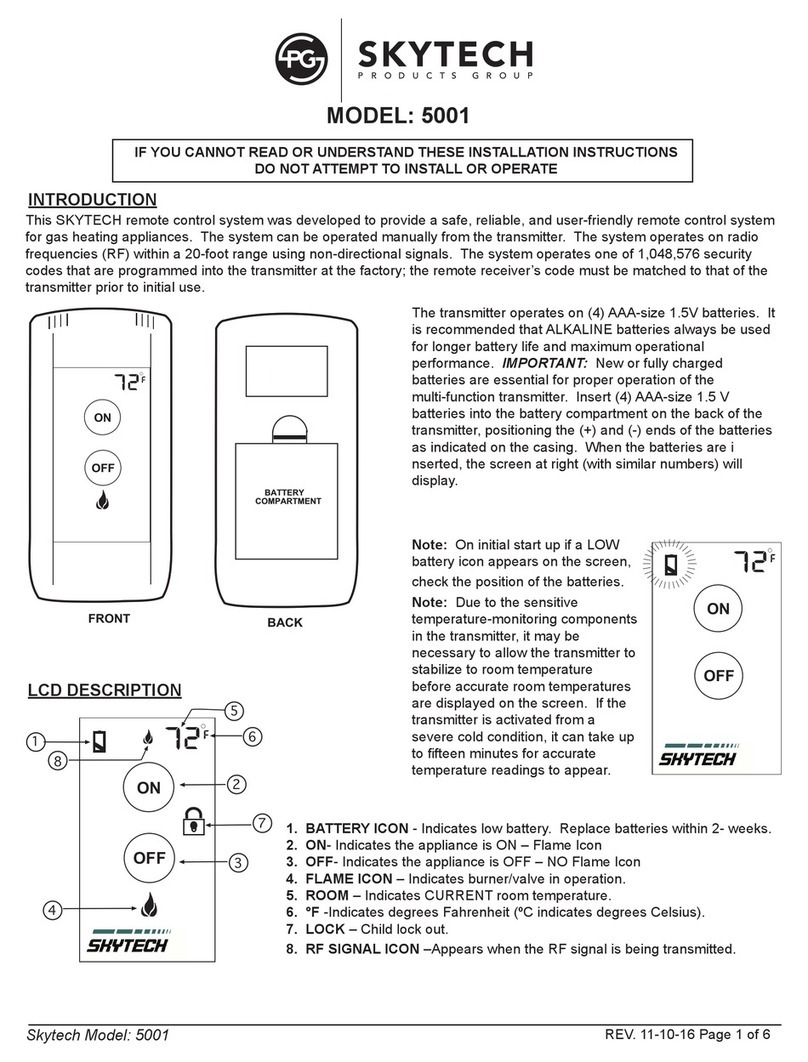
Skytech
Skytech 5001 installation instructions
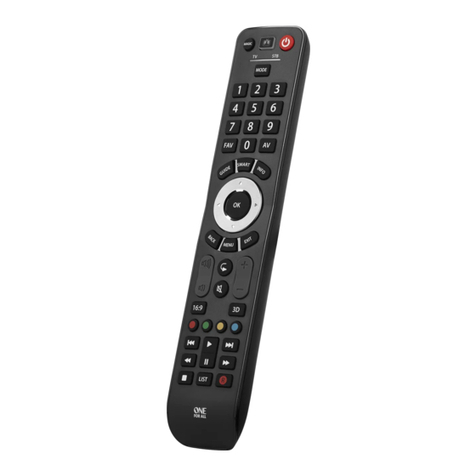
One Forall
One Forall URC7125 Simple setup guide
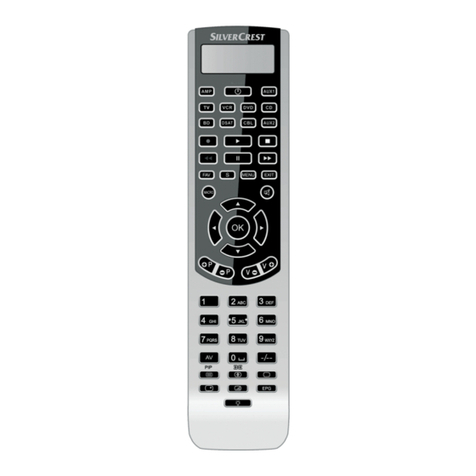
Silvercrest
Silvercrest SFB 10.1 C3 User manual and service information
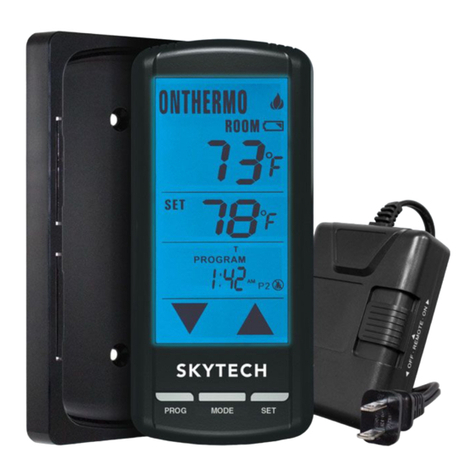
Skytech
Skytech 5320P Installation and operation instructions
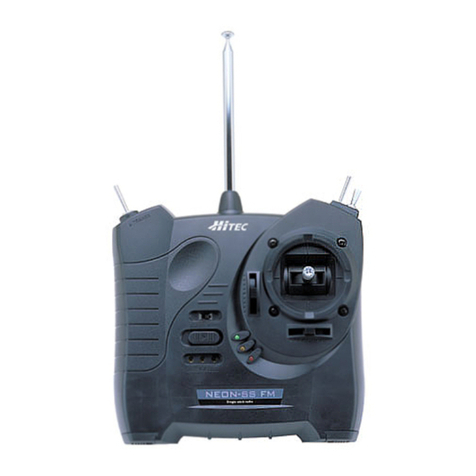
Hi-Tec
Hi-Tec NEON-SS FM instruction manual
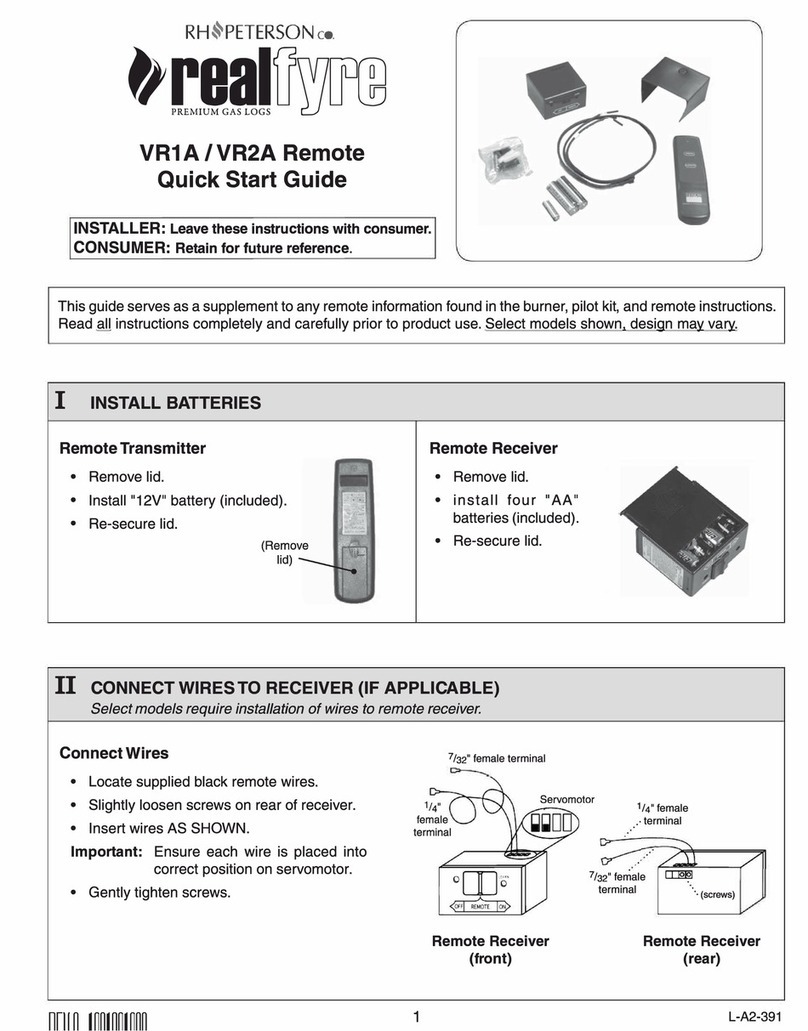
Real Fyre
Real Fyre VR1 A quick start guide

